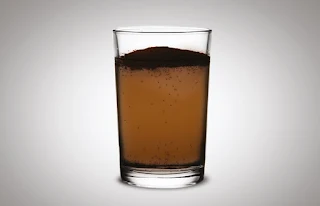Food is essential for sustenance of life. Adulteration of food deceive the consumer and can cause risk to their health. The purpose of this manual is to list out common methodologies available for food adulterants generally found in India.
The scope of this manual is meant for household, which can induce awareness among the consumer about food safety.
Test 1 : Detection of clay in coffee powder
Testing Method:
Adulterated
Test 2 : Detection of chicory powder in coffee powder
Testing Method:
Adulterated
Test 3 : Detection of exhausted tea in tea leaves
Test Method 1
Adulterated
Test Method 3
Testing Method:
Adulterated
Tags: Beverages adulterant Test at home
The scope of this manual is meant for household, which can induce awareness among the consumer about food safety.
Test 1 : Detection of clay in coffee powder
Testing Method:
- Add ½ teaspoon of coffee powder in a transparent glass of water.
- Stir for a minute and keep it aside for 5 minutes. Observe the glass at the bottom.
- Pure coffee powder will not leave any clay particles at the bottom.
- If coffee powder is adulterated, clay particles will settle at the bottom.
 |
| Pure |
Adulterated
 |
| Adulterated |
Test 2 : Detection of chicory powder in coffee powder
Testing Method:
- Take a transparent glass of water.
- Add a teaspoon of coffee powder.
- Coffee powder floats over the water but chicory begins to sink.
 |
| Pure |
Adulterated
 |
| Adulterated |
Test 3 : Detection of exhausted tea in tea leaves
Test Method 1
- Take a filter paper and spread few tea leaves.
- Sprinkle with water to wet the filter paper.
- Wash the filter paper under tap water and observe the stains against light.
- Pure tea leaves will not stain the filter paper.
- If coal tar is present, it will immediately stain the filter paper.
- Take small amount of tea leaves/ dust and place it in the centre of a filter paper.
- Add water drop by drop at the heap of the tea leaves/ dust.
- If the tea is adulterated with a coloured tea, water will dissolve the added colour and leave streak of colour in the filter paper.
 |
| Pure |
Adulterated
 |
| Adulterated |
Test Method 3
- Spread a little slaked lime on white porcelain tile or glass plate.
- Sprinkle a little tea dust on the lime.
- Red, orange or other shades of colour spreading on the lime will show the presence of coal tar colour.
- In case of genuine tea, there will be only a slight greenish yellow colour due to chlorophyll, which will appear after some time.
Testing Method:
- Take small quantity of tea leaves in a glass plate.
- Move the magnet through the tea leaves.
- Pure tea leaves will not show any iron filings on the magnet.
- If adulterated, then iron filings will be seen on the magnet..
 |
| Pure |
Adulterated
 |
| Adulterated |




















